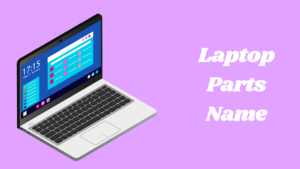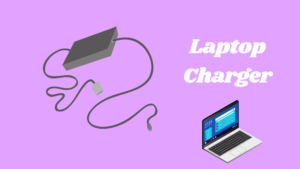
In this article, we will explain laptop part names and what functions they perform. Here is a more comprehensive list of hardware components and parts commonly found in a laptop.
Display Screen
The display screen of a laptop is the most important part, as it shows all the content and information on the laptop. It is made up of a liquid crystal display (LCD) or a light-emitting diode (LED) screen. The size of the display screen varies from 11 to 17 inches depending on the laptop model. The resolution of the display screen also varies from 720p to 4K.
Top Panel
The top panel of a laptop covers the display screen and is made of plastic, aluminum, or other materials. It also contains a webcam and a microphone for video calls and conferences. The top panel also has the laptop brand logo on it.
Base Panel
The base panel is the bottom part of the laptop, which contains the battery, ports, and cooling fans. It is usually made of plastic or aluminum. The base panel is designed in such a way that it provides stability and support to the laptop.
Keyboard
The keyboard is one of the essential hardware components of a laptop, which allows the user to type and input data. The keys are arranged in the QWERTY format and may contain additional keys for shortcuts, volume control, and brightness control. The keyboard is attached to the top panel of the laptop with a ribbon cable and can be removed and replaced.
Touchpad
The touchpad is located below the keyboard and is used to control the cursor on the display screen. It allows the user to perform various actions such as click, scroll, and drag. The touchpad is made of plastic and has a smooth surface, which is sensitive to touch.
Motherboard
The motherboard is the main circuit board of a laptop, which contains the CPU, RAM, graphics card, and other hardware components. The motherboard connects all the hardware components and allows them to communicate with each other. It also contains the BIOS (Basic Input/Output System) chip, which controls the startup process of the laptop. The motherboard is attached to the base panel of the laptop and can be replaced if necessary.
CPU
The CPU (Central Processing Unit) is the brain of the laptop, which performs all the calculations and processes data. The CPU is usually located on the motherboard and can be replaced if necessary. The speed and performance of the CPU vary depending on the model of the laptop.
RAM
The RAM (Random Access Memory) is the temporary memory of the laptop, which stores data and programs that are currently in use. The RAM is located on the motherboard and can be upgraded if necessary. The amount of RAM varies from 4 GB to 32 GB depending on the laptop model.
Hard Drive/SSD
The hard drive or solid-state drive (SSD) is the permanent storage of the laptop, which stores the operating system, files, and programs. The hard drive/SSD is located on the base panel of the laptop and can be upgraded if necessary. The storage capacity of the hard drive/SSD varies from 128 GB to 2 TB depending on the laptop model.
Graphics Card
The graphics card is responsible for rendering images and videos on the display screen. The graphics card can be integrated or dedicated. The integrated graphics card is located on the motherboard and shares the system memory, while the dedicated graphics card has its own memory and is located on the base panel of the laptop.
Battery
The battery is located on the base panel of the laptop and provides power to the laptop. The battery capacity varies depending on the laptop model and can be replaced if necessary.
Cooling System
The cooling system of a laptop is responsible for keeping the temperature of the hardware components at an optimal level. It consists of a fan and a heat sink, which dissipate the heat generated by the hardware components. The cooling system is located on the base panel of the laptop.
Speakers
The audio output devices allow the laptop to produce sound.
Ports
The physical connectors on the laptop that allow it to connect to external devices such as USB drives, monitors, and printers.
Wi-Fi and Bluetooth modules
Components that allow the laptop to connect to wireless networks and other devices.
What Are the Parts of a Laptop Charger?

A laptop charger, also known as an AC adapter or power supply, typically has the following parts:
- AC Power Cord: This is the cord that plugs into the wall outlet or power strip to provide power to the charger.
- DC Connector: This is the end of the charger that connects to the laptop’s power port. It typically has a barrel-shaped connector or a USB Type-C connector.
- Power Brick: This is the rectangular box that is in the middle of the charger cord. It is where the power conversion happens, changing the AC power from the wall outlet to the DC power needed by the laptop.
- LED Indicator: Some laptop chargers have a LED light on the connector or power brick that indicates when the charger is plugged in and charging the laptop.
- Cable Strain Relief: This is the portion of the charger where the cord meets the connector or power brick. It is designed to prevent the cord from bending or breaking at that point.
- Cooling Fan: Some high-powered laptop chargers may have a cooling fan to help dissipate heat generated by the charger during use.
- Circuitry and Safety Features: Inside the power brick, there is circuitry that regulates the power output to ensure that the correct voltage and amperage are delivered to the laptop. Additionally, many laptop chargers have safety features to protect against overvoltage, overcurrent, and short-circuiting.
Frequently ask question
What is the difference between RAM and ROM in a laptop?
RAM (Random Access Memory) is a type of memory that is used for temporary storage of data that the laptop is currently using, while ROM (Read-Only Memory) is a type of memory that is used for permanent storage of data that is needed by the laptop, such as the BIOS firmware.
How do I know which video card my laptop has?
You can find out which video card your laptop has by going to the Device Manager in the Windows Control Panel. Under the Display Adapters section, you should be able to see the name of your video card.
Can I upgrade the hard drive in my laptop?
In most cases, yes. Many laptops have a removable hard drive that can be upgraded to a larger or faster one. However, it’s important to check the specifications of your laptop to make sure that the new hard drive is compatible with your system.
What is a touchpad and how does it work?
A touchpad is a hardware component of a laptop that allows the user to control the cursor on the screen by moving their finger across the surface of the touchpad. It works by detecting the movement and pressure of the user’s finger and translating that into cursor movement.
How long should a laptop battery last?
The lifespan of a laptop battery can vary depending on the make and model of the laptop, as well as how the battery is used. In general, a laptop battery can last anywhere from 2 to 5 years with regular use, but this can be affected by factors such as temperature, usage patterns, and battery care.
Wrapping Up
A laptop computer is composed of various hardware components and parts that work together to provide a user with the ability to perform various tasks. The most visible hardware component is the display screen, which is responsible for displaying images and text. Other important hardware components include the keyboard, touchpad, motherboard, CPU, RAM, hard drive/SSD, graphics card, battery, and cooling system. These components are essential for a laptop to function properly and efficiently. Additionally, the wireless card and charger are also essential components that allow a user to connect to the internet and keep the laptop charged. Overall, understanding the different hardware components and parts of a laptop can help individuals to choose the right laptop for their needs and to make informed decisions about upgrades and repairs.
Thanks for reading!